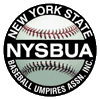The NFHS Baseball Rules Committee and the NFHS Board of Directors believes there are areas of the game of interscholastic baseball that need to be addressed and given special attention. These areas of concern are often cyclical, some areas need more attention than others, and that is why they might appear in the rules book for consecutive editions. These concerns are identified as “Points of Emphasis.” For the 2018 high school baseball season, attention is being called to: Sportsmanship (Bench Jockeying Celebrations, Negative comments between opponents), Jewelry Rule Enforcement, Administration of NFHS Rules, and Proper Pitching Positions. When a topic is included in the Points of Emphasis, these topics are important enough to reinforce throughout the academic year because they are not being given the proper attention.
Sportsmanship
National Anthem Standoff
The standing and singing of the national anthem is a valued tradition that is held prior to sporting events. Staring down an opponent after the national anthem, trying to intimidate them or refusing to leave the respective baseline before the other team departs is not consistent with the mission of education-based athletics. Coaches are the closest role models to these students and are held accountable for the behavior of their players as they represent their school and community. If those actions are not representative of high school sports and what they stand for, then corrective measures should take place.
Bench Jockeying, Celebrations and Negative Comments Between Opponents
Coaches, players, substitutes, attendants or other bench personnel shall not leave the dugout during live ball for any unauthorized purpose. Coaches or team personnel may not sit outside the dugout/bench on buckets or stools. Players are not allowed to stand or kneel outside their dugout/bench and make “cat-calls” or any other disparaging remarks while the other team is taking infield practice. Rooting for your team is an integral part of the high school baseball. However, making disparaging remarks toward your opponent does not improve the game, in fact it detracts from the contest. The purpose of interscholastic sports is educational. Chants/intentional distractions/loud noises (natural or artificial) directed at the opponent’s pitcher prior to his pitching, or the batter getting ready to hit, or a fielder getting ready to make a play is not good sportsmanship. We should strive to have our young people play to the best of their ability and let their natural talent be the barometer of their success.
This is unsportsmanlike behavior and shall not be tolerated in interscholastic baseball. Umpires and coaches need to work together for the benefit of the students they officiate and teach. It is these game situations that provide coaches and umpires excellent “teachable moments” to reinforce proper behavior and perspective. The positive values that are learned at the baseball diamond will serve the young people long after their high school careers have ended.
Enforcement of NFHS Jewelry Rule
Items that are attached except medical appliances/devices are considered to be jewelry. The primary cause for the restriction of jewelry is primary for risk minimization for the wearer and for their opponent. Earrings and various other piercings can be problematic for a player if the piercing gets caught on equipment and torn away from the body. Obviously, if a physician has provided documentation in support of a particular piercing, the local state association has the latitude (with proper justification) to make a special accommodation for the player. We need to be more vigilant to protect our players and their opponents.
Enforcement and Administration of NFHS Rules
The rules of high school baseball are written for the age and skill level of varsity high school players. The role of interscholastic athletics is not to prepare young people for the next level. In fact, the purpose of education-based athletics is three-fold. First, the purpose of high school baseball rules is to minimize risk. Secondly, the rules are designed to maintain the balance between offense and defense. Thirdly, the rules are to preserve the sound traditions of the game. Essentially, the NFHS and their member state associations use athletics to teach valuable life lessons. In addition, simplicity, fairness and ease to implement as an umpire or to teach or illustrate as a coach are additional reasons why our playing rules are designed in this manner. Other rules code have significantly different objectives and rationales for their rules.When non-approved interpretations or rulings that are contradictory to NFHS rules as written are used, they can confuse student, coaches, umpires and fans.
Proper Pitching Positions
The rules that govern the pitcher’s movement and his position on the pitcher’s plate have not varied over the years. However, modified or hybrid positions continually are developed and are attempted to be introduced into the high school game. While these creative pitcher's stances might work for advance levels of baseball, they are not appropriate for interscholastic baseball. Our rules are perfect for the age and skill level of the students we write playing rules for participation. The game has evolved over the years and new equipment and strategies have been very beneficial for our game. However, there are some things that stand the test of time and the proper position of the pitcher is one of those rules that enjoys a rich tradition.
The pitching requirements begin once he engages the pitcher’s plate. In NFHS sanctioned baseball there are only two positions the pitcher can possess, the windup and the set (also known as the stretch) position. The starting position of the non-pivot foot determines whether the pitcher is going to pitch from the windup or set position.
Pitchers in the windup position are required to have their non-pivot foot in any position on or behind a line extending through the front edge of the pitcher’s plate. If a pitcher’s non-pivot foot is in front of that line and he attempts to pitch from the windup, he has made an illegal pitch or committed a balk.
In the set position, he shall stand with his entire non-pivot foot in front of a line extending through the front edge of the pitcher’s plate and with his entire pivot foot in contact with or directly in front of the pitcher’s plate. He shall go to the set position without delay and in one continuous motion; he shall come to a complete and discernible stop, which does not include a change of direction with both hands in front of his body and his glove at or below his chin.
Going to the mouth while in contact with the pitcher’s plate is a balk, not because the pitcher goes to his mouth, but because the action simulates the start of the pitching motion.
Umpires must be aware of the position of the non-pivot foot. Practice the skills to determine if the pitch is legal or illegal. It is imperative that the pitching positions and movement are completely understood. These requirements provide guidance that the batter and base runner(s) know when they can swing and run and when the pitcher is in a position to deliver the ball, creating a level playing field for all involved with the game.

